Red Meat and Cancer Risk: Unraveling the Connection
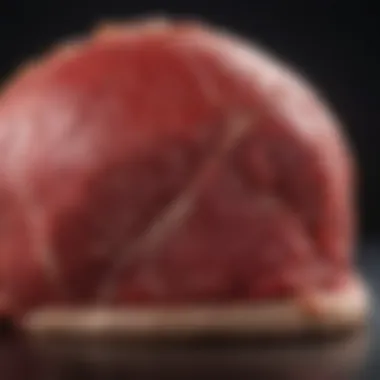

Intro
Red meat has long been a staple in many diets, but its association with cancer risk has sparked considerable debate among scientists, health professionals, and consumers alike. As populations become more health-conscious, understanding the nuances of this relationship is crucial. Numerous studies explore how the consumption of red meat can impact cancer risk, revealing complex interactions between dietary habits and health outcomes. This article provides an in-depth analysis of the intricate correlation between red meat consumption and cancer risk, examining biological mechanisms, epidemiological findings, and health guidelines.
Methodology
Overview of Research Methods Used
The investigation into the relationship between red meat and cancer draws from a range of research methods, including observational studies, randomized controlled trials, and meta-analysis. Observational studies, such as cohort studies, often track dietary habits and cancer incidences over extended periods, providing valuable data on long-term effects. Randomized controlled trials, albeit less common for dietary research, offer insights into direct effects by controlling variables more tightly.
Data Collection Techniques
Collecting data on red meat consumption typically involves dietary surveys and food frequency questionnaires. These tools help researchers gauge the quantity and frequency of red meat intake among participants. The studies also assess lifestyle factors, genetic predispositions, and other dietary components. Information is often cross-referenced with cancer registries to establish a more accurate picture of risk.
Findings
Biological Mechanisms
The biological mechanisms through which red meat consumption may influence cancer risk are complex. One hypothesis is that certain cooking methods, such as grilling or frying, can produce carcinogenic compounds. Additionally, red meat is high in heme iron, which can promote the formation of harmful substances in the gut. Other studies suggest that processed meats, which often contain preservatives like nitrates, may be particularly concerning.
Epidemiological Evidence
Epidemiological studies portray a varied picture. Research published by the World Health Organization classified processed meats as a Group 1 carcinogen and red meat as a Group 2A carcinogen, indicating they likely cause cancer. Various studies have linked high red meat consumption to increased risks of colorectal, pancreatic, and prostate cancer, but results can be inconsistent due to factors like cooking methods and accompanying dietary patterns.
Future Directions
Upcoming Trends in Research
Future research may focus on dietary patterns rather than isolated foods. Understanding the broader context in which red meat is consumed will provide clearer insights into its health impacts. Studies may also investigate the effects of different types of red meat, such as grass-fed versus grain-fed varieties, and how these choices affect cancer risks.
Areas Requiring Further Investigation
Additionally, understanding the genetic factors and individual responses to red meat intake remains a critical area for exploration. More studies are necessary to clarify the interplay between red meat consumption, gut microbiota, and cancer risk.
"Dietary habits are complex and intertwined with cultural practices, personal preferences, and health beliefs, making it crucial to approach red meat consumption with a nuanced understanding."
Epilogue
As the body of evidence regarding red meat and cancer risk continues to grow, educating the public about these risks, while promoting balanced dietary choices, remains paramount. Only through comprehensive research can guidelines be adapted to truly reflect the complexities of nutrition and health.
Preface to Red Meat and Cancer Risk
The relationship between red meat consumption and cancer risk has garnered increasing interest in both scientific and public health communities. Understanding this association is vital for developing effective dietary guidelines and informing the public about potential health risks associated with red meat consumption. As red meat is a staple in many diets worldwide, its consumption raises critical questions regarding health implications, particularly concerning cancer.
Defining Red Meat
Red meat mainly refers to the meat obtained from mammals, including beef, lamb, and pork. Unlike poultry or seafood, red meat has a higher myoglobin content, leading to its darker color. The classification can further extend to processed meats, which are preserved by methods like smoking, curing, or adding preservatives. Common examples include sausages, bacon, and ham. These distinctions are essential due to differing health risks associated with each type of meat, particularly in relation to cancer.
Historical Perspectives on Red Meat Consumption
Historically, red meat has been an integral part of human diets across diverse cultures. Ancient civilizations relied heavily on livestock for sustenance. As societies evolved, the methods of meat production and preparation also changed. In the modern world, the consumption of red meat has been a topic of contention among nutritionists and health experts.
Some studies indicate that increased red meat intake correlates with higher incidents of several types of cancers. These findings urge consumers to examine their dietary habits and balance their red meat intake with other sources of nutrition. The historical context helps elucidate current trends in consumption patterns and health recommendations. Recognizing the long-standing role of red meat in diets assists in understanding why its link to cancer risk is a topic of fervent discussion today.
"Understanding the historical significance of red meat can reveal much about contemporary health concerns surrounding its consumption."
In summary, comprehending the implications of red meat consumption is crucial. Consumers and health professionals alike must stay informed about the complex interplay between dietary habits and cancer risk to promote better health outcomes.
Scientific Basis of Cancer Development
Understanding the scientific basis of cancer development is crucial for evaluating the link between red meat consumption and cancer risk. This section provides insights into fundamental biological processes that contribute to cancer formation, emphasizing cellular mechanisms and the factors involved. By dissecting these elements, readers can grasp how dietary choices, particularly the intake of red meat, may influence cancer outcomes. A solid grasp of these mechanisms helps in the formulation of effective dietary guidelines and personalized nutrition strategies aimed at reducing cancer risk.
Cellular Mechanisms of Carcinogenesis
Carcinogenesis is the process through which normal cells transform into cancer cells. This transformation is complex and involves several key stages. Firstly, genetic mutations play a pivotal role in the development of cancer. Any alteration in the DNA sequence can lead to uncontrolled cell proliferation. Red meat has been associated with the production of compounds, such as heterocyclic amines, that can induce these mutations.
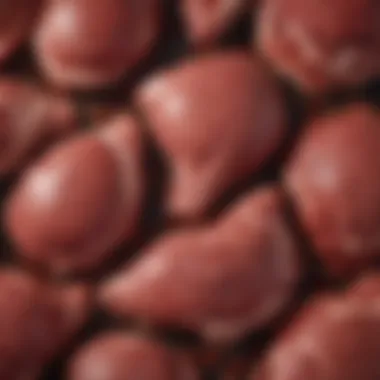
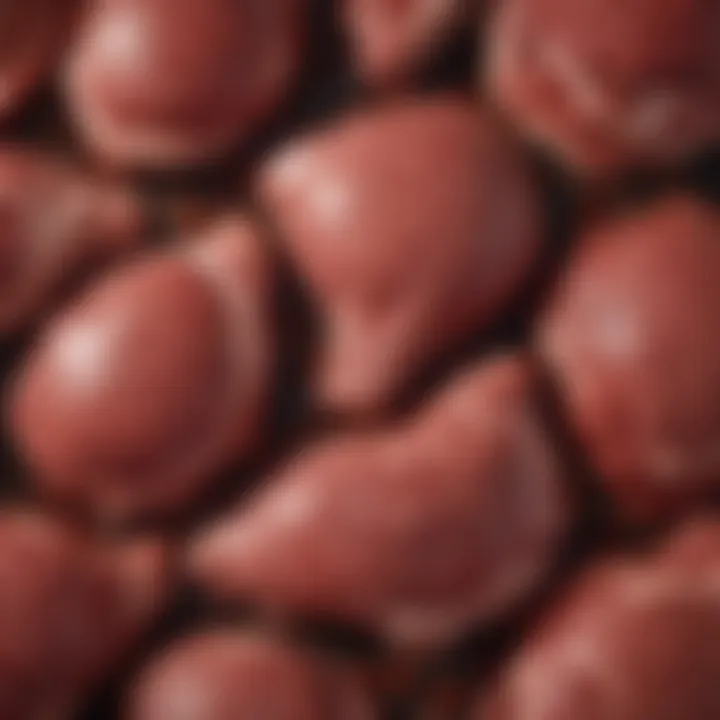
The process can be broken down into three phases: initiation, promotion, and progression.
- Initiation occurs when a carcinogen causes a permanent mutation in the DNA of a cell.
- Promotion involves the enhancement of these mutated cells' growth. High-fat diets, including excess red meat, may amplify this effect by creating an environment that favors rapid cell division.
- Progression is the final stage, marking the shift from benign growth to malignancy.
Research indicates that specific aspects of red meat processing and cooking can increase the likelihood of mutations. For instance, cooking methods that generate high temperatures can produce mutagenic compounds which add further complexity to this relationship.
The Role of Mutagens and Carcinogens
Mutagens and carcinogens are substances that induce mutations and have the potential to cause cancer, respectively. The consumption of red meat can expose individuals to various carcinogenic compounds. For example, nitrate and nitrite preservatives used in processed meats can lead to the formation of N-nitroso compounds, which are known to be potent carcinogens.
Additionally, cooking meat at high temperatures, such as grilling or frying, can lead to the formation of heterocyclic amines and polycyclic aromatic hydrocarbons. Both of these compounds have been linked to increased cancer risk, notably colorectal cancer.
In 2015, the International Agency for Research on Cancer classified processed meat as a Group 1 carcinogen, indicating sufficient evidence that it can cause cancer in humans.
This underscores the need for individuals and health organizations to consider both the type of meat consumed and the cooking methods employed. Moreover, understanding these scientific elements encourages a proactive approach to dietary choices, aiming to minimize exposure to these harmful substances.
Epidemiological Evidence Linking Red Meat and Cancer
Understanding the epidemiological evidence relating red meat consumption to cancer risk is crucial in this discourse. Epidemiological studies explore the relationship between diet, health, and disease in populations. This section provides insights that help inform dietary guidelines and health recommendations. With numerous studies indicating increased cancer risk associated with red meat, it becomes essential to scrutinize the data to extract meaningful conclusions. Epidemiological findings can shape public health policies and dietary habits on a global scale.
Types of Cancer Associated with Red Meat
Colorectal Cancer
Colorectal cancer is one of the most commonly linked cancers to red meat consumption. Numerous studies show a correlation between high red meat intake and an elevated risk of developing this particular type of cancer. Colorectal cancer is marked by factors like lifestyle and dietary choices, making it a significant focus for researchers. The digestibility and processing of red meat might contribute to changes in intestinal flora, which can impact tumor development. This characteristic makes colorectal cancer a compelling choice for exploration in the context of red meat and cancer risk. Its well-documented association provides valuable insight into how diet can influence cancer outcomes.
Pancreatic Cancer
Pancreatic cancer has also been discussed in relation to red meat consumption. Research indicates that high levels of red meat may lead to an increased risk for this malignancy. The specific risk factors for pancreatic cancer arise partly from the nutrients and substances present in certain types of red meat, which can promote cancerous changes in cells. Its unique association underscores the need for further examination of dietary habits concerning cancer prevention. Pancreatic cancer’s often late detection posits a further challenge in understanding its link to red meat, hence making it a critical aspect of cancer risk discussions.
Prostate Cancer
Prostate cancer represents another area of concern when evaluating red meat consumption. Evidence suggests a possible link, especially in populations with high red meat intake. The specific mechanisms that connect red meat to prostate cancer are still the subject of ongoing research. Factors such as saturated fats and hormones can be potential players in cancer progression. Prostate cancer's high prevalence in men accentuates the importance of studying dietary influences on this disease. This provides a beneficial avenue for connecting dietary choices with health outcomes for men, emphasizing the need for targeted dietary recommendations.
Statistical Analysis of Risk
Statistical evaluations of cancer risk associated with red meat consumption reveal a complex picture. Various cohort studies and meta-analyses offer insights into how significant the impact of red meat can be. For example, meta-analysis might aggregate data from numerous studies to present a clearer picture of risk associations. Researchers often use statistical significance to determine if observed links are reliable. Additionally, factors such as type of meat, degree of processing, and cooking methods are scrutinized in these analyses.
Ultimately, statistical evidence provides critical context to understand the true risks and inform the public. It helps shape evidence-based dietary guidelines and health communication strategies.
Types of Red Meat and Their Impact
Understanding the types of red meat and their specific impacts on health is vital in the discussion around cancer risk. This section will explore the distinctions between processed and unprocessed red meat as well as provide a comparative analysis of different types, including beef, pork, and lamb. Each type presents unique properties and implications for health, making it essential for readers to consider how these meats fit into their overall dietary habits.
Processed vs. Unprocessed Red Meat
Processed red meat refers to meats that have been preserved by smoking, curing, or adding salt. Examples include bacon, sausages, and deli meats. On the contrary, unprocessed red meats are those that are fresh and have not undergone these preservation methods, such as fresh beef, lamb, and pork.
The distinction is important because processed meats have been shown to carry a higher risk of cancer compared to their unprocessed counterparts. The World Health Organization has classified processed red meat as a Group 1 carcinogen, indicating sufficient evidence of its link to colorectal cancer. Unprocessed red meats, while still potentially associated with certain health risks, do not share the same level of evidence regarding carcinogenic effects.
Some factors affecting the risk associated with processed meats include:
- Sodium content: Often high in processed meats, which can lead to elevated blood pressure.
- Preservatives: Chemicals used may form harmful compounds when consumed.
- Preparation methods: Grilling or frying can char processed meats, increasing harmful substances.
In contrast, unprocessed red meat may offer nutritional benefits, such as iron and protein. However, moderation remains crucial, as excessive intake can still lead to health issues.
Beef, Pork, and Lamb: A Comparative Analysis
The comparative analysis of beef, pork, and lamb reveals nuanced differences in their health impacts. Beef is often the most consumed type of red meat globally and has been associated with higher rates of certain cancers, particularly colorectal cancer. Studies indicate that compounds formed during digestion, such as N-nitroso compounds, may play a role in this increased risk.
Pork is another prevalent source of red meat. Its consumption has been less directly linked to cancer risk when compared to beef, yet there are concerns regarding how it is processed. For instance, bacon is processed and carries similar risks as other processed meats.
Lamb, while less commonly consumed, has its own set of characteristics. It generally contains more conjugated linoleic acid, which might possess some protective effects, although research is still limited in scope.
When evaluating red meats, consider the following factors:
- Consumption levels: Higher intakes of any red meat, especially processed varieties, correlate with increased cancer risk.
- Cooking methods: How each type of meat is prepared can influence its health outcomes significantly.
- Nutritional content: Each meat offers varied nutrients, and understanding these can guide healthier choices.
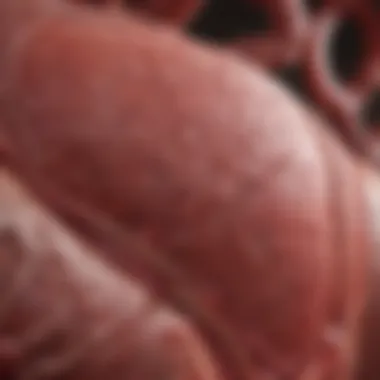

"Red meat consumption is not inherently bad, but discernment in choice and preparation can mitigate health risks."
Influence of Cooking Methods on Cancer Risk
Understanding how cooking methods affect cancer risk is crucial in the discussion of red meat consumption and its potential health impacts. Certain preparation techniques can alter the chemical composition of the meat and, consequently, impact its carcinogenic properties. Research suggests that the way red meat is cooked can lead to the formation of harmful compounds that may increase the risk of cancer. Insights into these methods provide guidance for healthier cooking practices.
High-Temperature Cooking and Heterocyclic Amines
High-temperature cooking methods such as grilling, frying, and broiling are often linked to the formation of specific carcinogenic compounds known as heterocyclic amines (HCAs). These compounds are produced when amino acids and creatine, which are found naturally in meat, react at elevated temperatures. Studies indicate that the longer and hotter meat is cooked, the greater the production of HCAs. The implications are significant; frequent consumption of meats prepared by these methods may correlate with a higher incidence of certain cancers, particularly colorectal cancer.
To mitigate the formation of HCAs, some suggest using lower cooking temperatures or employing methods such as marinating meat. Marinades can contain ingredients that may inhibit the creation of these harmful compounds. Additionally, using techniques like baking or steaming can significantly reduce the levels of HCAs compared to frying or grilling.
"The type of cooking method can significantly influence the potential risk of cancer associated with red meat consumption."
Grilling, Frying, and Their Effects
Grilling and frying are popular cooking methods for red meat, but they also raise concerns regarding health risks. Grilling meat, especially over an open flame, can lead to the formation of polycyclic aromatic hydrocarbons (PAHs), another group of harmful compounds linked to cancer. PAHs can form when fat drips onto the heat source and creates smoke that contains these toxic substances, which can then adhere to the surface of the meat.
Frying, especially in high-temperature oil, poses similar risks. Not only can frying create HCAs, but it can also introduce potentially harmful substances from the oil itself. Additionally, cooking red meat with certain oils can produce other toxic compounds that may contribute to health risks. Therefore, it is important to consider the choice of oil as well as the cooking method.
In summary, the influence of cooking methods on cancer risk is an area of emerging research. It highlights the need for dietary awareness and cautions against high-temperature cooking techniques that may compound the risks associated with red meat consumption.
By making informed choices about cooking methods, individuals can reduce potential health risks while still enjoying red meat as part of their diet.
Dietary Guidelines on Red Meat Consumption
Red meat consumption has long been a subject of health discussions, especially regarding its potential links to cancer. Understanding dietary guidelines on this matter is important for making informed choices. The guidelines aim to provide clarity on safe consumption levels and health risks associated with red meat.
Research indicates a correlation between high intake of red meat and the risk of various cancers, particularly colorectal cancer. Therefore, dietary recommendations often suggest moderation. A balanced diet includes a variety of protein sources, potentially reducing reliance on red meat. These guidelines also underline the need for a holistic view of one's lifestyle, considering factors such as exercise and overall diet composition.
Global Dietary Recommendations
Certain global health organizations have offered dietary recommendations regarding red meat. For instance, the World Health Organization (WHO) emphasizes a diet low in processed meats. They suggest limiting red meat consumption to around 500 grams per week. This threshold aims to help mitigate cancer risk while still allowing for nutrient intake from red meat. Countries often adapt these guidelines based on local dietary practices.
- Key elements of global dietary recommendations:
- Limit processed meats intake.
- Consume red meat in moderation.
- Prefer lean cuts to reduce fat consumption.
- Focus on plant-based protein sources.
National Health Organizations' Stance
National health organizations often align with global recommendations but may also provide localized guidance. For example, the American Cancer Society advises individuals to limit red and processed meats in their diets as part of cancer prevention strategies. They recommend consuming no more than 18 ounces of cooked red meat per week. Similarly, the UK’s National Health Service advocates a balanced diet that prefers poultry and fish over red meats.
"The stance taken by national agencies reflects a growing understanding of the health implications associated with excessive red meat consumption."
These positions focus not only on cancer prevention but also on promoting overall health. Such guidelines stress the importance of incorporating a variety of foods leading to a more balanced and healthful diet.
Alternatives to Red Meat in Diet
The current conversation about red meat and its association with cancer risk has prompted many to consider alternatives to this protein source. The increasing evidence suggests that frequent consumption of red meat, especially processed varieties, may contribute to negative health outcomes. Hence, evaluating alternative dietary options can benefit both health and wellbeing.
In recent years, a paradigm shift towards plant-based eating has gained traction. This shift is fueled by an understanding of how certain foods can contribute to improved health outcomes. Finding suitable alternatives to red meat is crucial not only for individuals concerned about cancer risk but also for those looking to maintain a balanced and nutritious diet.
Plant-Based Protein Sources
Plant-based proteins present a wealth of health benefits. Foods such as beans, lentils, chickpeas, quinoa, and various nuts are excellent protein sources. They often come with additional advantages such as fiber, vitamins, and minerals, which red meat generally lacks. Incorporating these sources into daily meals can reduce reliance on red meat while avoiding potential health risks.
- Beans and Lentils: These legumes are high in protein, fiber, and complex carbohydrates. They promote satiety and help in regulating blood sugar levels. A study indicates that diets rich in fiber are linked to lower risks of certain cancers.
- Chickpeas: Popularly used in dishes such as hummus, chickpeas are versatile and nutrient-dense. They can easily replace meat in salads, stews, or curries.
- Quinoa: This grain-like seed contains all essential amino acids, making it a complete protein. It is gluten-free and can be an excellent substitute for rice or couscous.
- Nuts and Seeds: Almonds, walnuts, chia seeds, and flaxseeds provide healthy fats along with protein. They can serve as snacks or be added to smoothies.
Exploring these protein sources can be a nutritious way to pivot away from red meat.
Poultry and Seafood Options
When considering alternatives to red meat, poultry and seafood can serve as effective substitutes. Chicken, turkey, fish, and shellfish have lower saturated fat content compared to red meat. They can deliver necessary proteins and essential nutrients.
- Chicken and Turkey: Lean meats such as skinless chicken and turkey can provide essential protein at lower health risks than red meat. They are versatile, easily incorporated into various dishes from grilling to roasting.
- Fish: Fish varieties, especially fatty fish like salmon and mackerel, contain omega-3 fatty acids. Omega-3s have evidential support for benefits in reducing inflammation and may even help in cancer prevention.
- Shellfish: Options such as shrimp, scallops, and mussels offer protein along with vitamins and minerals. They are generally low in calories and can be an excellent addition to numerous meals.
In summary, the alternatives to red meat offer various nutritional benefits alongside important considerations regarding health risks. By focusing on plant-based proteins and lean animal proteins like poultry and seafood, individuals can reduce their cancer risk while still enjoying a well-rounded diet. This shift may play an important role in public health conversations going forward.
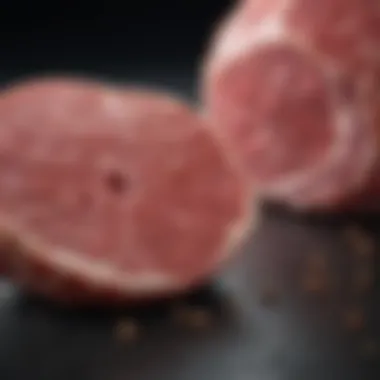

Integrating these alternatives not only aids in health promotion but also supports sustainable dietary practices, addressing broader environmental issues.
The Role of Genetics in Cancer Risk
Understanding the role of genetics in cancer risk is fundamental in unpacking the relationship between red meat consumption and cancer. Genetic factors can influence how an individual metabolizes certain compounds in red meat, including potential carcinogens. They also determine susceptibility to various types of cancer. This section addresses two critical subtopics: hereditary factors and genetic predisposition, and the interaction between diet and genetics. Both elements illuminate how personal genetics can shape cancer risks associated with dietary choices, especially regarding red meat.
Hereditary Factors and Genetic Predisposition
Hereditary factors play a substantial role in determining cancer susceptibility. Certain mutations in genes, such as BRCA1 and BRCA2, have been extensively studied in the context of breast and ovarian cancer. While these mutations are not directly linked to red meat consumption, they highlight the importance of genetics in cancer risk. Genetic predisposition can also refer to other less commonly known hereditary syndromes, like Lynch syndrome, which is connected to colorectal cancer risk.
Individuals with these genetic predispositions may experience a higher risk of cancer when combined with specific dietary patterns, including high red meat consumption. For example, those with a family history of colorectal cancer might be advised to limit red meat in their diets in light of their genetic background.
Interaction Between Diet and Genetics
The interplay between diet and genetics is another critical area of discussion. Recent research suggests that genetic factors can influence how dietary elements are metabolized, which includes the consumption of red meat. Genetic variations can affect the absorption and processing of nutrients and potential carcinogens found in red meat, such as heme iron or certain preservatives in processed meats.
A practical example includes individuals who may have genetic variants that impact the detoxification of harmful substances. If such individuals consume large amounts of processed red meat, they may experience a heightened risk of developing cancer compared to those with different genetic makeups.
Moreover, some studies indicate that certain diets can modify gene expression through mechanisms like epigenetics. This suggests that what you eat may not only affect overall health but can influence how one's genes work. For some, adapting dietary habits such as reducing red meat intake can be a means to mitigate genetically influenced cancer risks.
In summary, personal genetics significantly shape the relationship between red meat consumption and cancer risk. Genetic predisposition, coupled with dietary choices, creates a complex interplay that demands consideration in cancer prevention strategies.
By recognizing these connections, individuals and healthcare professionals can make more informed nutritional choices that consider both genetic factors and cancer risks. The evolving landscape of nutritional genomics continues to ignite interest and research, underscoring the critical moves toward personalized dietary recommendations.
Current Research Trends in Nutritional Oncology
Current research in nutritional oncology explores the relationship between diet, specifically red meat consumption, and cancer risk. Understanding these trends is crucial for developing effective public health policies. With a surge in studies focusing on diet as a modifiable risk factor, researchers aim to elucidate mechanisms linking red meat to various cancers. This section will highlight emerging findings and innovations shaping the discourse on nutrition and cancer.
Emerging Studies on Red Meat and Cancer
Recent studies investigate the specific components of red meat that may elevate cancer risks. For instance, the association between heme iron from red meat and increased colorectal cancer has gained attention. Researchers observe that heme iron can generate free radicals, which can damage DNA and contribute to cancer development. Some studies suggest that cooking methods and preservatives present in processed meats exacerbate these risks.
A significant study by the World Health Organization in 2015 classified processed meats as carcinogenic, further fueling research. Ongoing investigations aim to understand how genetic predisposition interacts with dietary choices. This dual approach allows for a more comprehensive risk assessment and suitable dietary modifications.
"The intricate relationship between dietary choices and cancer risk continues to unfold, leading to groundbreaking insights in nutritional oncology."
Technological Advances in Nutrition Research
Technological advancements have revolutionized how researchers study the impact of dietary components on cancer risk. Techniques like metabolomics and genomics facilitate deeper insights into how red meat consumption affects metabolic pathways linked to cancer development.
- Metabolomics, the study of metabolites, allows scientists to observe how red meat consumption alters metabolic profiles, providing clues to understanding cancer risks.
- Genomic studies examining the variability in genetic responses to diet lead to a more personalized approach in cancer prevention strategies.
Additionally, artificial intelligence is playing an increasing role in analyzing vast datasets. Researchers leverage machine learning to identify patterns and correlations that traditional methods might overlook. This leads to more refined dietary guidelines and enhances the efficacy of preventive measures against cancer.
In summary, the current research landscape in nutritional oncology reflects a nuanced understanding of the role of red meat in cancer risk. Emerging studies and technological innovations are pivotal, providing a clearer framework for potential dietary interventions and informing public health strategies.
Closures and Future Directions
The exploration of red meat consumption and its complex association with cancer risk provides a multifaceted understanding of dietary choices in relation to health. It is essential to synthesize findings and reflect on how they might inform public health policies and individual dietary guidelines. By examining data across various studies, one can see that while red meat can carry certain health risks, particularly when processed or cooked at high temperatures, it is also important to consider personal dietary choices in the context of overall health and lifestyle.
There are several key components to consider moving forward in both research and public health strategies. One critical aspect of these conclusions is the need for a balanced view of red meat within a diversified diet, acknowledging both potential risks and benefits. This nuanced perspective can better equip individuals making informed decisions regarding their nutritional intake.
"Integrating scientific research findings into practical dietary guidelines is essential for promoting public health without vilifying specific food groups."
Integrating Findings into Public Health Policies
Incorporating recent findings about red meat and cancer risk into public health policies is crucial. By doing so, authorities can develop clearer dietary guidelines. These guidelines should reflect current scientific understanding while considering cultural and social factors related to food.
Some considerations include:
- Education and Awareness: It is vital to educate the public about the risks associated with excessive red meat consumption, particularly processed varieties. People should be made aware of healthier cooking methods and alternatives available.
- Personalized Nutrition: Tailoring dietary recommendations based on individual health profiles can help mitigate risk while still providing nutritional benefits of red meat.
- Collaboration with Industry: Working closely with the food industry can yield better product labeling and healthier options that cater to consumer demand for low-risk red meat products.
The role of nutritionists and health educators in disseminating this information cannot be overlooked, as these professionals are integral to ensuring that the message reaches diverse populations effectively.
Areas for Further Research and Investigation
Future research should focus on several areas to fill gaps in the existing knowledge about red meat consumption and cancer risk. Understanding the finer details of how red meat impacts different populations may reveal crucial insights.
Potential areas for exploration may include:
- Longitudinal Studies: Carrying out long-term studies that track individual dietary habits and their cancer outcomes can provide more definitive conclusions.
- Mechanisms of Action: Further investigation into the specific biological mechanisms by which red meat may contribute to cancer, including the role of cooking methods and chemical additives.
- Cultural Factors: Researching how cultural perceptions of red meat influence dietary choices across different ethnic groups could yield valuable data on health disparities.
- Alternative Proteins: As more people turn away from red meat, studies examining the health impacts of plant-based diets or alternative protein sources can offer insights into nutritional adequacy and cancer prevention.
In summary, comprehending the complex relationship between red meat and cancer risk is a dynamic process. Thus, an ongoing commitment to research and policy development is essential to foster a health-conscious society.







